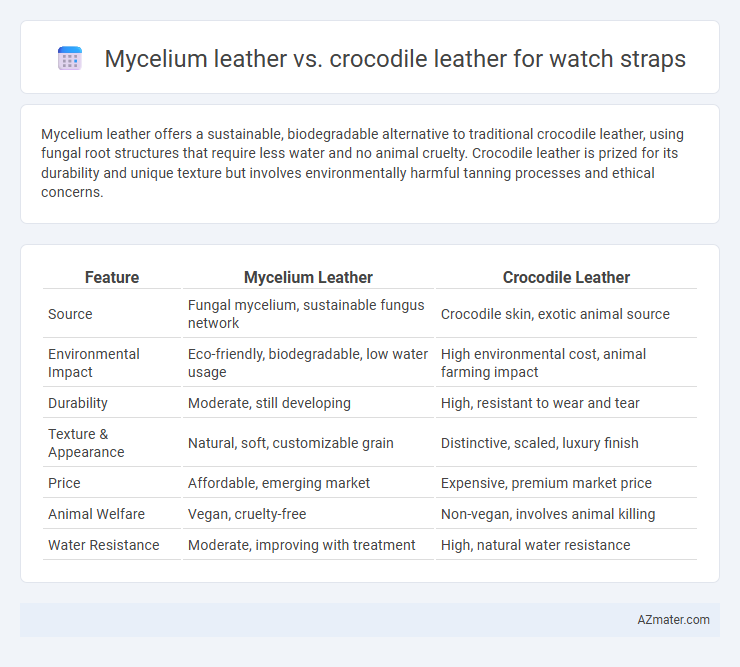Mycelium leather offers a sustainable, biodegradable alternative to traditional crocodile leather, using fungal root structures that require less water and no animal cruelty. Crocodile leather is prized for its durability and unique texture but involves environmentally harmful tanning processes and ethical concerns.
Table of Comparison
| Feature | Mycelium Leather | Crocodile Leather |
|---|---|---|
| Source | Fungal mycelium, sustainable fungus network | Crocodile skin, exotic animal source |
| Environmental Impact | Eco-friendly, biodegradable, low water usage | High environmental cost, animal farming impact |
| Durability | Moderate, still developing | High, resistant to wear and tear |
| Texture & Appearance | Natural, soft, customizable grain | Distinctive, scaled, luxury finish |
| Price | Affordable, emerging market | Expensive, premium market price |
| Animal Welfare | Vegan, cruelty-free | Non-vegan, involves animal killing |
| Water Resistance | Moderate, improving with treatment | High, natural water resistance |
Introduction to Alternative Leathers for Watch Straps
Mycelium leather offers an eco-friendly and sustainable alternative to traditional crocodile leather for watch straps, crafted from the root structure of mushrooms, which provides durability and flexibility comparable to exotic animal skins. Crocodile leather remains prized for its distinctive texture and luxury appeal but raises environmental and ethical concerns due to habitat destruction and animal welfare issues. Choosing mycelium leather supports innovative, vegan-friendly materials that reduce carbon footprint while maintaining premium quality and aesthetic for high-end watch straps.
What is Mycelium Leather?
Mycelium leather, made from the root structure of mushrooms, offers an eco-friendly and sustainable alternative to traditional animal leathers like crocodile leather. This innovative material is biodegradable, cruelty-free, and boasts exceptional durability and flexibility, making it ideal for watch straps. Unlike crocodile leather, which involves ethically and environmentally contentious practices, mycelium leather supports cruelty-free fashion with a significantly lower carbon footprint.
Understanding Crocodile Leather
Crocodile leather is prized for its distinctive scale patterns, durability, and luxurious texture, making it a premium choice for watch straps that signify status and elegance. This exotic leather undergoes a meticulous tanning process to enhance its natural flexibility and resistance to wear, ensuring long-lasting quality. In comparison, mycelium leather offers a sustainable alternative but lacks the innate rugged sophistication and heritage associated with crocodile leather in luxury timepieces.
Sustainability and Environmental Impact
Mycelium leather offers a significant sustainability advantage over crocodile leather, as it is produced from fungal roots requiring minimal water, no animal harm, and generates lower carbon emissions. Crocodile leather involves intensive farming practices that contribute to habitat destruction, high water consumption, and chemical pollution from tanning processes. Choosing mycelium leather watch straps reduces environmental impact while supporting cruelty-free fashion innovations.
Durability and Longevity Comparison
Mycelium leather offers high durability due to its dense, fibrous structure that resists wear and maintains flexibility over time, making it a sustainable alternative for watch straps. Crocodile leather is renowned for its exceptional strength and natural water resistance, providing long-lasting durability with distinctive texture that ages gracefully. While crocodile leather typically outperforms in traditional toughness and patina development, mycelium leather presents a comparable lifespan with enhanced environmental benefits and consistent quality.
Aesthetic Appeal and Texture Differences
Mycelium leather offers a smooth, consistent texture with a matte finish, creating a modern, eco-friendly aesthetic ideal for sleek watch straps. Crocodile leather boasts a distinctive, glossy surface with natural scale patterns, providing a luxurious and classic appearance that enhances high-end timepieces. The tactile contrast between mycelium's soft, pliable feel and crocodile's firm, textured grain caters to different style preferences and comfort levels.
Comfort and Wearability
Mycelium leather offers exceptional breathability and flexibility, making it highly comfortable for extended wear as a watch strap. Crocodile leather, known for its durability and distinctive texture, can feel stiffer and require more break-in time, potentially reducing initial wearability. The lightweight nature of mycelium leather also enhances everyday comfort compared to the denser crocodile leather.
Ethical Considerations
Mycelium leather offers a sustainable and cruelty-free alternative to crocodile leather, reducing environmental impact through biodegradable and renewable materials. Crocodile leather involves animal farming and often raises ethical concerns about wildlife conservation and animal welfare. Choosing mycelium leather supports eco-friendly practices while avoiding the ethical issues linked to exotic leather sourcing.
Price and Market Availability
Mycelium leather offers a significantly lower price point compared to crocodile leather, making it an affordable alternative for watch straps. Crocodile leather remains a premium, high-cost material due to its rarity and traditional luxury status, limiting its market availability to specialized retailers. Mycelium leather gains broader market presence through sustainable brands, addressing growing demand for eco-friendly and cost-effective watch strap options.
Which Leather is Better for Watch Straps?
Mycelium leather offers superior sustainability and flexibility compared to crocodile leather, making it an eco-friendly choice for watch straps without compromising durability. Crocodile leather excels in luxury markets due to its unique texture and long-lasting strength, but it requires more intensive maintenance and raises ethical concerns. For watch straps, mycelium leather provides a modern, cruelty-free alternative with comparable longevity and comfort, ideal for environmentally conscious consumers.

Infographic: Mycelium leather vs Crocodile leather for Watch strap
 azmater.com
azmater.com